Where in the World is Bhutan

Located in southern Asia at the easternmost edge of the Himalayas, Bhutan is a landlocked country with a total area of 14,824 square miles, sharing its 708-mile border with the People’s Republic of China and Tibetan China to the north and northwest and The Republic of India to the south, southwest and east. Given its rugged terrain, only 123 square miles constitute irrigated land, despite the fact that upwards of 55% of Bhutanese make their living in agriculture. With an average elevation of 10,761 feet above sea level, Bhutan’s highest peak can be found at Gangkhar Puensum, which stands at 24,836 feet above sea level and to this day maintains the distinction of being the highest unclimbed mountain in the world. Violent storms originating in the Himalayas give the country its name, which translates into English as Land of the Thunder Dragon.
Land of Happiness
A second nickname for Bhutan is the “Land of Happiness,” since the Bhutanese people continue to take pride in the traditions of their ancestors, helping to perpetuate cultural values such as compassion, kindness and respect for others, which in turn ranks the sovereign nation as one of the happiest countries in the world and the happiest in all of Asia. Divided into 20 districts known as dzongkhags and 205 village blocks or gewogs for administration, Bhutan’s climate varies by region, from the tropical southern plains to the cool winters and hot summers of the central valleys, while severe winters and cool summers make up the highlands region. Boasting a population of 782,455 Bhutanese, the most populated part of the nation lies in the western highlands, including Bhutan’s capital city of Thimphu, which is home to just shy of 115,000 people.
Small but Thriving
After the British East India Company began contracting Bhutan’s borders through a number of wars and subsequent peace treaties, Bhutan’s current size was set by the 1865 Treaty of Sinchula, when some borderland regions were ceded back from India. With an annual GDP of $2.768 billion, Bhutan’s natural resources include timber, gypsum, calcium carbide and hydroelectric power, the later supporting the Bhutanese economy through extensive exports to India. Other industries include wood products, processed fruits and alcoholic beverages, and while the nation is heavily reliant on India for financial aid, in 1974, the Bhutanese government began promoting Bhutan’s unique culture and traditions to the outside world, which now averages some 300,000 tourists a year, primarily from India, Bangladesh and the Maldives, making the nation of Bhutan, a welcoming destination in far southern Asia.
